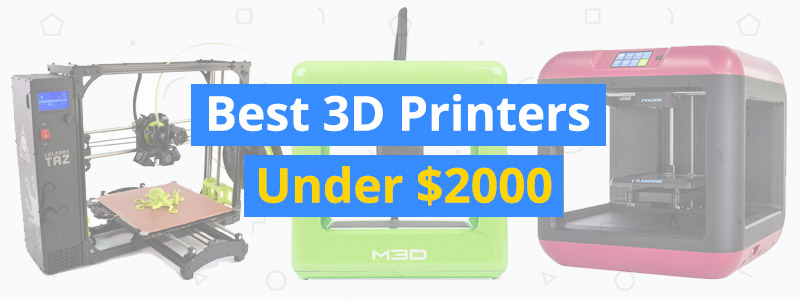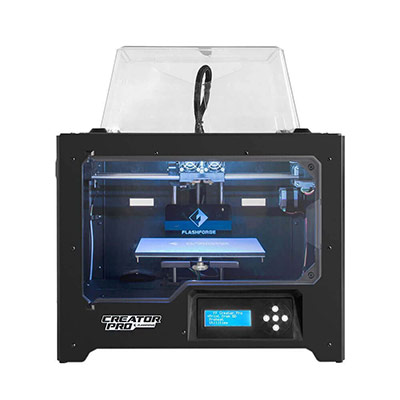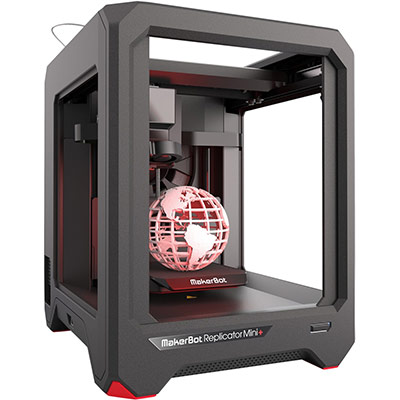Best 3D Printers Under $2000
With so many options available on the market, shopping for a $2000 3D printer can be a real nightmare. It’s time-consuming, exhausting, and confusing. Not to mention, you can easily fall into marketing traps and end up with the wrong 3D printer.
We’re here to make sure you get it right the first time. In this guide, we cover the best 3D printers that you can get for less than $2000 – and we mean only the best of the best. So, no, you won’t encounter any of those cheap 3D printers that you can buy for less than $500. We have separate guides for that.
| Budget |
|---|
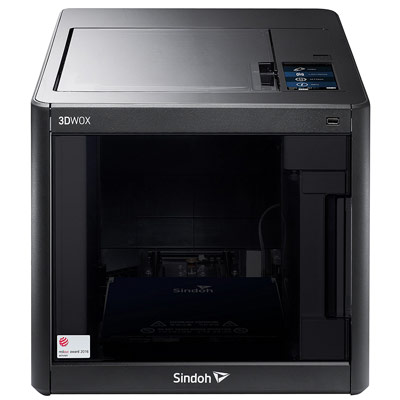 |
| SINDOH 3DWOX DP200 |
| 4.5/5.0 |
| Wi-Fi, USB |
| 33.1 lb |
| Auto-loading filament system and remote monitoring via Wi-Fi. |
| Check Amazon |
| Best Value |
|---|
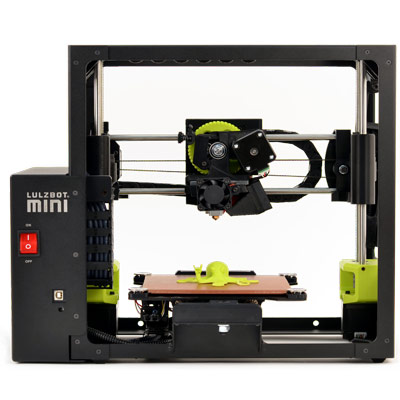 |
| LULZBOT MINI |
| 4.6/5.0 |
| USB |
| 18.9 lb |
| Fast-heating build plate and good technical support. |
| Check Amazon |
| Top Pick |
|---|
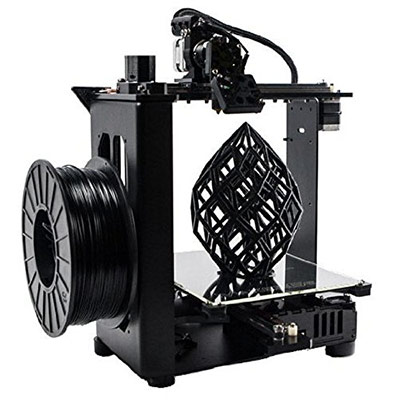 |
| MAKERGEAR M2E |
| 4.7/5.0 |
| USB, SD card |
| 26.5 lb |
| Ready to print in less than 30 minutes and terrific print quality. |
| Check Amazon |
Here’s a quick glance at the products you’ll see in this guide.
Best 3D Printers Under $2000 Comparison Table
| Make and Model | Weight | Connectivity | Price |
|---|---|---|---|
| MakerGear M2e | 26.5 lb | USB, SD card | Check Price |
| Sindoh 3DWOX DP200 | 33.1 lb | Wi-Fi, USB | Check Price |
| LulzBot Mini | 18.9 lb | USB | Check Price |
| FlashForge Creator Pro | 37.5 lb | USB, SD card | Check Price |
| MakerBot Replicator Mini Plus | 20.5 lb | Wi-Fi, USB | Check Price |
Here are the in-depth descriptions of each product:
1. MakerGear M2e
Editor’s Rating: 4.7/5
If you have a $2000 budget, you best make it count because it’s not every day you get to spend two grand on a 3D printer. But since no 3D printer is ever perfect, regardless of price range, the best option is to go for a 3D printer that brings excellent value and simply gets the job done with minimal issues.
Introducing the MakerGear M2e, a 3D printer that delivers exactly just that. It’s the fifth generation of the M2 series of 3D printers – a series marked by outstanding quality and reliability. It arrives in a well-secured package, so you don’t have to worry about broken parts suffered during shipping, which is a common issue with 3D printers manufactured in China.
The open-framed M2e sports a handsome all-black finish that makes it look good on any work desk. It’s equipped with a single extruder and comes with a built-in spool holder, which reduces the machine footprint. Overall, the design is sound and well thought-out, with no instances of oddly placed parts.
One of the main selling points of the M2e is that it works right out of the box. No need to assemble it and spend hours on the initial setup, which can be a daunting process for those unfamiliar with electronics. Even though the instruction manual is less than perfect, setting up the M2e shouldn’t take more than one hour. If you know your way around electronics, you can go from unboxing to printing your first item in less than 30 minutes.
Configuring the M2e to optimum settings is another story, though. The instruction manual only covers the basics, so you can’t rely on it to guide your hand. For tips and detailed instructions on how to get the M2e to top form, you need to visit dedicated forums on the internet.
The M2e will not disappoint you once it goes to work. It supports various type of filaments, including ABS, PLA, TPU, HIPS, and more advanced materials that beginners shouldn’t play around with at first. It has a large build size – one of the most generous in this class – and produces accurate results with outstanding print quality. It prints fairly fast, too, though the actual print speed depends on several parameters such as the material used and the configured resolution.
If you can afford it, we recommend that you buy the Simplify3D software right off the bat. The M2e’s default printing software isn’t exactly terrible. But for the best and most consistent results, use Simplify3D. In fact, MakerGear recommends that you use Simplify3D, which fits the M2e like a glove, so to speak.
A recommended starter 3D printer for beginners, the M2e is one of the best 3D printers that you can get without blowing past $2000. It’s well-built, easy to use, and can print different types of filaments with consistently high quality. It’s also made in the US – Beachwood, Ohio, to be more specific – so you get to support the local economy with your purchase.
| Tech Specs |
|---|
| Resolution: 50 microns |
| Volume: 8 x 10 x 8 in |
| Filament: 1.75 mm |
| Type: ABS, PLA, HIPS, and others |
| Weight: 26.5 lb |
| Connect: USB, SD card |
| The Pros |
|---|
| Ready to print in less than 30 minutes |
| Easy to use and manually calibrate |
| Large maximum print size |
| Terrific print quality |
| Heated build plate |
| Open-source hardware and software |
| Supports various filament types |
| Reliable customer service |
| Helpful online community |
| The Cons |
|---|
| No cover |
| Noisy |
| Single extruder |
2. Sindoh 3DWOX DP200
Editor’s Rating: 4.5/5
The Sindoh 3DWOX DP200 is the most plug-and-play 3D printer that you can get for less than $1000. It’s so easy to set up that you’ll find it almost ridiculous that you don’t have much to work with during the initial setup.
Most pre-built 3D printers take about 30 minutes to a couple of hours to set up, which includes calibrating the machine and installing the printing software. But with the DP200, you can go from unboxing to printing in 10-20 minutes, depending on how fast you can read the instruction manual. It includes a number of features designed to make 3D printing as painless as possible for beginners, especially the non-techie ones.
On the hardware side, the DP200 comes with an assisted bed leveling system that turns bed leveling into a trivial matter. All you need to do is turn the gears under the print bed according to the instructions on the touchscreen interface and you’re good to go. Loading the filament is equally easy, thanks to the auto-loading filament system. Just pop the filament inside the machine and … well, that’s it. The machine takes care of everything else once the cartridge is loaded.
Inside, the DP200 sports a removable print bed that allows for quick removal of finished projects. It’s got great adhesion by default, so you don’t need to resort to tricks such as applying glue or tape. All the moving parts are secured inside the printer, giving it a clean and professional look. It’s also equipped with a built-in camera, which allows for remote monitoring of your progress (via Wi-Fi).
On the software side, the DP200 ships with the 3DWOX Desktop printing software. It’s a user-friendly software that includes an easy mode for beginners, which is really neat. It’s the biggest reason why that 10-20 minutes initial setup time is possible. Once you’re ready to move on to more complicated printing settings, you can always switch to Cura or Solidworks.
It’s hard not to feel impressed with the DP200’s print quality. It’s nearly on the same level as 3D printers that go for twice the price. Think about it for a moment. For just $800, you get a 3D printer that can produce results comparable to that of 3D printers floating above $1500. Factor in the DP200’s generous build volume, which allows for more ambitious projects, and you have yourself an absolute steal.
Impressed so far? Here’s some bad news for you: the DP200 requires you to use proprietary PLA and ABS filament. It’s the price for that useful auto-loading filament system. Force the DP200 to eat a third-party filament and you lose the load-and-go setup. Not to mention, it becomes more prone to filament-related errors.
If you want a 3D printer that lets you start printing in just a few minutes, buy the DP200. It’s the closest thing you can get to a true plug-and-play 3D printer in this price range. It’s fully enclosed for consistent temperatures, with the option to open the top, and is also backed by a helpful customer support. Excluding the proprietary filament issue, Sindoh got everything right with the DP200.
| Tech Specs |
|---|
| Resolution: 50 microns |
| Volume: 7.9 x 7.9 x 7.3 in |
| Filament: 1.75 mm |
| Type: ABS, PLA |
| Weight: 33.1 lb |
| Connect: Wi-Fi, USB |
| The Pros |
|---|
| Extremely easy to set up |
| Fully enclosed |
| Assisted bed leveling system |
| Auto-loading filament system |
| Remote monitoring via Wi-Fi |
| Large build size |
| Easy-to-use touchscreen interface |
| User-friendly default software |
| Excellent customer support |
| The Cons |
|---|
| Requires proprietary filament |
| Limited to PLA and ABS filaments |
3. LulzBot Mini
Editor’s Rating: 4.6/5
If the MakerGear M2 and the Sindoh 3DWOX DP200 – our choices for Best Pick and Best Budget, respectively – had a crossover, the result would be the LulzBot Mini. So it’s only fitting that it’s our pick for Best Value, which represents a nice balance between value and affordability.
The LulzBot Mini is a non-enclosed 3D printer with all the moving parts fully exposed. It’s housed in a sturdy frame, which keeps it steady while printing. The power box is attached to the side, so it has a smaller footprint compared to other open-framed 3D printers, which usually come with a bulky control box. Even with the mechanisms fully exposed, the LulzBot Mini still projects a professional appearance.
Much like the DP200, the LulzBot Mini requires very little tinkering to get it ready. It’s not a stretch to categorize it as a plug-and-play 3D printer. It arrives assembled and only needs about 30 minutes for the initial calibration and software installation. Bed leveling is a breeze due to the auto-leveling system that – get this – actually works.
The custom Cura printing software is the other ingredient that makes the transition from unboxing to printing a seamless process. It’s designed with ease-of-use in mind. It’s easy to navigate and includes straightforward options for slicing your 3D models.
The LulzBot Mini’s print quality is consistent and accurate. It includes a fast-heating print bed that does not need gimmicks to achieve reliable adhesion. It can be configured to print different types of materials, including ABS and PVA. It has a decent-sized build volume, though you may find it inadequate for more ambitious and complex projects.
Tinkerers will love the LulzBot Mini. It’s a completely open-source 3D printer that you can modify however you want. It can be augmented with 3D-printed parts and is compatible with most 3D printing software, including Slic3r, MatterControl, and OctoPrint. For in-depth information on how to mod your LulzBot Mini, check out specific guides on the internet.
Since it is open-framed, the LulzBot Mini is exposed to dust and other particles, so you need to be diligent with the maintenance. The exposed heated build plate and print head also mean the LulzBot Mini is not a recommended 3D printer for kids to use, no matter how beginner-friendly it is. But if you insist on letting your kids use it, we recommend that you also purchase a dedicated enclosure for it.
For connection, the LulzBot Mini is limited to direct USB connection by default – no standalone printing via SD card and certainly no wireless printing via Wi-Fi. The lack of a wireless option isn’t really a big deal. The non-existent support for standalone printing, however, can be really inconvenient, especially if you want your 3D printer and your computer to be on separate desks.
If you want a 3D printer that you can grow with while you learn the ins and outs of 3D printing, look no further than the LulzBot Mini. It’s a beginner-friendly 3D printer with an open-source structure that allows for a good amount of tinkering and customizations.
| Tech Specs |
|---|
| Resolution: 50 microns |
| Volume: 6 x 6 x 6.2 in |
| Filament: 3 mm |
| Type: ABS, PLA, PVA, and others |
| Weight: 18.9 lb |
| Connect: USB |
| The Pros |
|---|
| Initial setup takes less than 30 minutes |
| Hassle-free bed leveling |
| Open-source |
| Fast-heating build plate |
| Excellent print bed adhesion |
| Good technical support |
| Optimization guides readily available online |
| The Cons |
|---|
| Limited to tethered USB connection |
| No enclosure |
4. FlashForge Creator Pro
Editor’s Rating: 4.4/5
It’s not often you run into a dual extruder 3D printer that you can buy for less than $1000. In fact, we found only two or three products that are worth at least a second look, and the FlashForge Creator Pro is the best of the bunch by a significant margin.
A fully enclosed 3D printer, the Creator Pro is an affordable MakerBot clone that arrives in a neat and well-secured package, which is critical for a delicate machine that ships from halfway across the globe. It ships with everything you need to get started right away, including a pair of filaments and a set of tools and spare parts.
The initial setup is quick and easy. It should take about 30 minutes to one hour to get everything ready, depending on your technical aptitude. The instruction manual is easy to follow, though it can be vague sometimes, so a fair amount of guesswork is needed in some areas. It’s best to watch guides on YouTube to make sure you’re doing it right.
The Creator Pro’s print quality is good for a 3D printer under $1000. It’s detailed and accurate, although don’t expect stellar results during your first few tries. In order to get results that you can be proud of, you need to play around with the settings and see what works. But we recommend that you ditch the default software and replace it with a more versatile 3D printing software such as Simplify3D, OctoPrint, Slic3r, and MakerWare.
Equipped with a heated print bed, the Creator Pro can print using different types of filament, including ABS, flexible, and nylon, provided you have the correct settings in place. For better adhesion and quick removal of finished 3D models, we suggest that you replace the default print bed with a glass bed.
The Creator Pro is compatible with third-party filaments. But here’s the catch: the spool holders are designed specifically for FlashForge filaments, so most rolls of filaments either slide off or don’t fit at all. In short, you need to craft your own set of external spool holders for third-party filaments.
As you can see, the Creator Pro needs a bit of modding right off the bat. It’s the reason why we went with the similarly priced Sindoh 3DWOX DP200 as our budget pick. If you’re willing to put in the effort, the Creator Pro has the potential to outgun more expensive 3D printers.
Everything considered the Creator Pro is still a solid 3D printer. It’s ideal for tinkerers and those who are open to modding and customizations. If you want a FlashForge 3D printer that’s more plug-and-play than the Creator Pro, check out the FlashForge Dreamer instead.
| Tech Specs |
|---|
| Resolution: 100 microns |
| Volume: 8.9 x 5.8 x 5.9 in |
| Filament: 1.75 mm |
| Type: ABS, PLA, Flexible, and others |
| Weight: 37.5 lb |
| Connect: USB, SD card |
| The Pros |
|---|
| Fully enclosed |
| Dual extruder setup |
| Heated build plate |
| Easy to set up and calibrate |
| Good print quality |
| Compatible with commercial software |
| Supports third-party filaments |
| Reliable technical support |
| The Cons |
|---|
| Loud |
| Limited default software |
| Needs glass bed |
| Needs separate spool holders for third-party filaments |
5. MakerBot Replicator Mini Plus
Editor’s Rating: 4.3/5
If you want a mini 3D printer with a wireless connectivity that actually works, the MakerBot Replicator Mini Plus is for you. It’s the bigger and better version of the original Replicator Mini, boasting a larger build size and a faster printing speed.
The Replicator Mini Plus is housed in a striking open frame, with a built-in filament holder at the back. It has a small footprint and, at 20.5 lb, is lightweight enough for easy transport around the house or in the classroom. It doesn’t have an onboard interface for direct control– everything is controlled from your computer or smartphone.
Inside, the Replicator Mini Plus boasts a factory-leveled print bed, so you no longer need to go through the manual bed leveling process, which can be tricky and time-consuming. It’s got a built-in camera for remote monitoring of your progress and a “smart extruder” that automatically pauses during a filament jam. Moreover, the smart extruder – officially called the “MakerBot Smart Extruder Plus – can tell if the printer is out of filament.
Like all the other 3D printers listed here, the Replicator Mini Plus is incredibly easy to set up. The initial configuration runs through the MakerBot application. Just follow all instructions and your printer will be up and running in no time.
The default software is user-friendly. It’s easy to navigate and includes straightforward options, allowing beginners to quickly get acquainted with 3D printing settings. But on the flip side, the default software lacks more advanced options, which can be a turn-off, even a deal-breaker, for hobbyists and tinkerers.
The Replicator Mini Plus boasts a clean and detailed print quality. It prints relatively fast, too, with small trinkets taking only a few hours to complete – although the actual print speed ultimately depends on the printing settings. In general, the higher the resolution of the 3D model, the longer the completion time.
Unlike the LulzBot Mini, the Replicator Mini Plus is limited to PLA filaments, which is why MakerBot never bothered to include a heated print bed. Even worse, the Replicator Mini Plus sort of forces you to use MakerBot’s expensive filaments.
Sure, you can use third-party filaments, but good results are not guaranteed if you go down that route. MakerBot explicitly tells you that the Replicator Mini Plus is optimized for their own filaments. So if you want consistency, stick to MakerBot filaments. In addition, the built-in spool holder is designed specifically for MakerBot filament rolls. If you’re adamant about using third-party filaments, you need to build your own external spool holder.
The Replicator Mini Plus is also not the quietest 3D printer around. It’s very loud while printing. It’s not exactly eardrums-breaking, but it’s loud enough to make you thankful that you have the ability to control the printer and check your progress from a distance.
If you want a premium mini 3D printer but don’t like the LulzBot Mini for whatever reason, the Replicator Mini Plus is a great alternative. It’s reliable, easy to use, prints fast, and comes with a wireless connection option, which is uncommon for a mini 3D printer.
| Tech Specs |
|---|
| Resolution: 100 microns |
| Volume: 4 x 5 x 5 in |
| Filament: 1.75 mm |
| Type: PLA |
| Weight: 20.5 lb |
| Connect: Wi-Fi, USB |
| The Pros |
|---|
| Small machine footprint |
| Intuitive app-based initial setup |
| Fairly fast print speed |
| Filament run-out notifications |
| Filament jam detection and auto-pause |
| Remote progress monitoring and control |
| Excellent adhesion on quick-release print bed |
| No manual bed leveling required |
| The Cons |
|---|
| Loud |
| Optimized for expensive MakerBot filaments |
| Limited to PLA |
| Limited printing software |
| No onboard interface |
Contents

